 You wouldn’t think to look at it but my scrub plane is rather posh – it’s a Lie Nielsen which I’ve had from new so to many people (including myself) it may seem a bit extravagant for a roughing tool. Previously I’ve just converted an old Number 4 to serve this job and would never have considered it necessary to purchase a dedicated tool but then many years ago Helen bought me this as a gift and I now wouldn’t be happy with anything less.
You wouldn’t think to look at it but my scrub plane is rather posh – it’s a Lie Nielsen which I’ve had from new so to many people (including myself) it may seem a bit extravagant for a roughing tool. Previously I’ve just converted an old Number 4 to serve this job and would never have considered it necessary to purchase a dedicated tool but then many years ago Helen bought me this as a gift and I now wouldn’t be happy with anything less.
I generally feel that for roughing tools I’m happy going with something old or cheap as they don’t tend to need much refinement but since having this scrub plane I’ve find many, many advantages to having something built specially for the purpose.
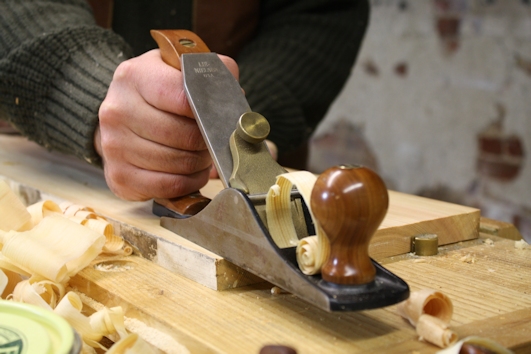 Firstly my hands are like shovels and the design of the scrub plane as opposed to the Number 4 allows me to get a nice firm grip on the handle so I can control it with just one hand. Since I find it’s in my hand for at least 60% of my stock preparation the one handed grip has become vital for me to work at any speed. With one hand on the tool I can use my other to keep progress fast, moving the board so it’s always against my single stop and lifting it regularly to examine and check the progress. It’s such a comfortable grip that I can even take a quick stroke whilst I’m holding the board up and sighting down it.
Firstly my hands are like shovels and the design of the scrub plane as opposed to the Number 4 allows me to get a nice firm grip on the handle so I can control it with just one hand. Since I find it’s in my hand for at least 60% of my stock preparation the one handed grip has become vital for me to work at any speed. With one hand on the tool I can use my other to keep progress fast, moving the board so it’s always against my single stop and lifting it regularly to examine and check the progress. It’s such a comfortable grip that I can even take a quick stroke whilst I’m holding the board up and sighting down it.
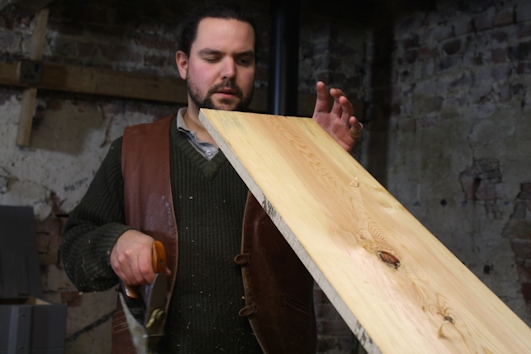
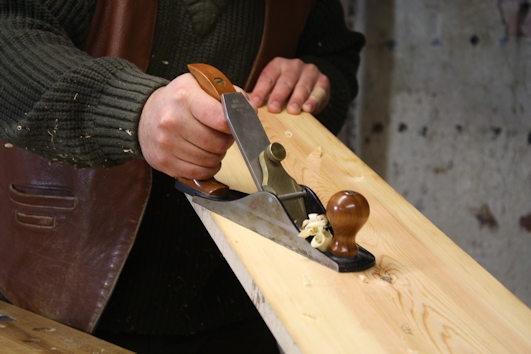 In addition to the grip there’s it’s extremly solid build and lovely thick iron which take it to different level for this task compared with a dainty Number 4. For the odd bit of thicknessing in nice clear pine I don’t feel this advantage would become so noticable but I am certainly grateful whenever I go clunking over a knot or am working hardwoods.
In addition to the grip there’s it’s extremly solid build and lovely thick iron which take it to different level for this task compared with a dainty Number 4. For the odd bit of thicknessing in nice clear pine I don’t feel this advantage would become so noticable but I am certainly grateful whenever I go clunking over a knot or am working hardwoods.
I always keep the iron in my scrub plane nice and sharp, as sharp as any of my finely set planes and the solid build helps it absorb everything that I throw it at. My old, battered jack plane is a very different story, it has loads of play between the parts and a thin little blade but I love it all the more since it works perfectly for it’s own job. My jack is also set with a heavy cut but I use it after the scrub to roughly level things out, and so for the most part it’s taking off the ridges left behind which is no where near as demanding.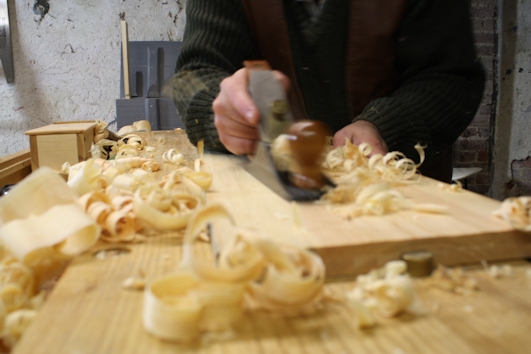 I often wander if Helen hadn’t bought me this plane would I have ever considered purchasing something so posh for a rough job, and to be honest I don’t think I would. Now that I’ve used it for so long though I would definitely buy another one if it got broken or a dirty rotter stole it. This little scrub plane is the equivilant of my thicknesser when I’m building furniture so there’s a lot to be said for having a solid tool to aid me.
I often wander if Helen hadn’t bought me this plane would I have ever considered purchasing something so posh for a rough job, and to be honest I don’t think I would. Now that I’ve used it for so long though I would definitely buy another one if it got broken or a dirty rotter stole it. This little scrub plane is the equivilant of my thicknesser when I’m building furniture so there’s a lot to be said for having a solid tool to aid me.

![Which Saws Are Best For Ripping Thick Stuff? [Video]](https://www.theenglishwoodworker.com/wp-content/uploads/2022/12/what-hand-saw-is-best-for-thick-rip-cuts.jpg)
![How do I Sharpen a Router Plane? [Q & A Video]](https://www.theenglishwoodworker.com/wp-content/uploads/2022/11/how-to-sharpen-a-router-plane-video.jpg)
![Bench Top Edge Jointing [with Video]](https://www.theenglishwoodworker.com/wp-content/uploads/2022/10/bench-top-edge-jointing-video.jpg)
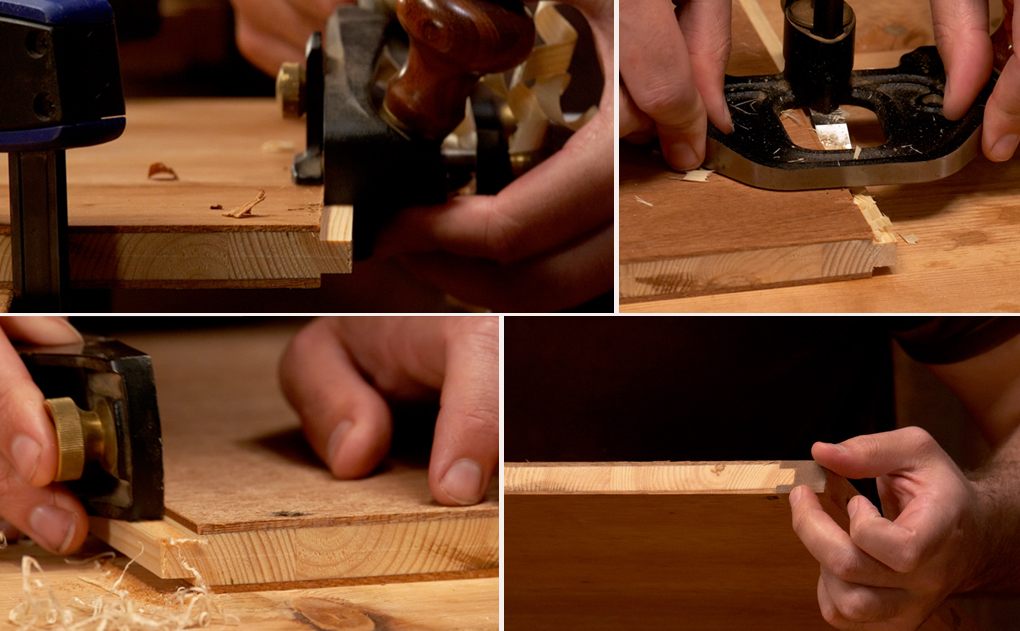
If you are going to have a scrubber, get a good one. 😉
Couldn’t agree more, Richard. I used to use an ordinary plane converted to perform as a scrub but a couple of years ago I bought the Veritas scrub plane and it’s now one of my favourite planes. There’s nothing to beat a purpose-made plane, designed and built specifically for the job.
Thank you for nudging the waffling decision to the positive as to whether I really need one of these. I really wasn’t sure it could be a justifiable purchase. Now, I’ll have to save up for certain!
Interesting one-handed approach. I will have to give that a go….
Richard,
Glad you get along well with the scrub plane. Looks like it fits your hand okay. That blade looks about twice as thick as the Stanley 40.
I see only one bandaid on your fingers. : ) Things must be going good with work and the new place. Stay safe.
Mike
enjoyed this a lot richard, but here is the confession, ive been a woodworker for a long time now, and hand tools have not been in the play, and for that im really sorry, if i could go back in time , i would have gone hand tools verses power, yes power has its place, but, i have to say i love the thought of working wood this way, i do have some nice planes that have come from friends, but i dont know that much, so the question, will you ever consider talking about the planes to us who know little, if not i certainly can follow along, but coming from you sure would be nice…
Richard, I wholeheartedly agree. I tried the #4 with a highly cambered blade. It performed better than I would have thought. However, once I got and used my LV scrub plane, I would never go without it. Those knots and hardwoods can be a bear to dimension…without the scrub. It is one hearty tool and I’ve learned that it’s quite versatile. When I learned that the old timers used to use it also for dimensioning the width of boards that brought a whole new use for it. Sometimes it’s easier to use it versus a handsaw to rip off a small strip.
I could be wrong, but isn’t it an unwritten woodworking rule that no tool can be too posh and no blade too sharp.
I started out with a no.5 with its original blade ground round but it wasn’t the material-eater the books lead me to believe it would be. After another woodworker confirmed my suspicion that Stanley blades are pretty wimpy, I purchased a thicker Veritas replacement blade. That beautiful, brand-new $40 blade sat on my desk for about two months before I got up the nerve to camber and use it.
Hello Richard!
Do You use the scrub with or across the grain?
I use an old Stanley #5 with a cambered blade and recently a wooden jack plane. I love the way a wooden plane glides on the wood and despite being much bigger than the former, it is similiar in weight, so it seems lighter. I also noticed for myself, that going across the grain allows for a much, much heavier cut, but going with grain gives me more control of the boards plane (curve, twist etc.). I personally have an esthetic thing for the razee style planes, especially jacks…but haven’t used one yet. I think they might be great, as they have the smaller size of the #5 or scrub and the benefits of a wooden plane.
You wrote, that You use the wooden jack after the scrub…does that mean that the sequence You use is: scrub, wooden jack, jointer/Veritas Jack (as in the videos) and then maybe smoother?
Kindest regards,
Lukasz.
I’d like to hear your thoughts on upgrading old Stanleys, specifically
a) a “better”/thicker iron (e.g. Veritas, Samurai, Hock)
b) a better rear tote. The Stanley totes are too small for my mitts.
in light of this post, where both features get mentioned….
(My current intent is upgraded Stanley bedrocks for scrubbing & jointing and a low angle bevel up Veritas for smoothing and shooting. The issue being how to upgrade.)
Cheers
Stephan
I converted my Record No. 5 into a scrub plane by purchasing a scrub plane blade and cap iron from Hock Tools. The new blade will also work in my Record No. 4. The blade was ground and all I had to do was hone it.
Quite often, when beginning to prepare a board by hand and using the scrub plane diagonally, the edges can get spelched. It’s therefore a good idea to dimension the boards wider than you need to start with. Then you can use the scrub plane on the edges to quickly bring the width close to a line, finishing with the jointer.
In fact, I read somewhere that this was the scrub plane’s original use, and that the No 5, or jack plane, was for the cross grain initial flattening.
Mine’s a LN and it’s great to use.
By the way, I have a method for modifying old Stanleys to take a LN blade and the depth adjuster work. This makes old planes really sing.
This my friend is Christopher Schwarz theory but even he isn’t actually sure about that. I don’t believe for a sec. The scrub plane was primarily used on edges only as I don’t own a scrub plane because I’m too busy fussing over should I convert a no.5 into one or just purchase the LN I can tell you thicknessing a board without one is a pain in the but and just draws out the work unnecessarily.
Have the same plane, love mine too.
I finally bought one today I sharpened it to a razor finish and put it to work, I tried various thicknesses and there’s no way in bloody hell I can shave an 1/8 of an inch even a 16th is unbearable. I ended up taking chunks out of pine. I also did an edge test and with only a few passes without realising I went below my line and ended up tapering it. I know I will have to get used to it I plan on doing just that over the weekend.
I have had a Veritas scrub for years and find it works a treat for the rough stuff. Recently I helped a friend work on levelling the end grain of a big (36 x 40″) walnut burl slab. We needed to take 1/2″ thickness off one side and prep the rest for sanding and finishing. The scrub worked almost scary-fast and with much less sweat than the heavy-camber jack plane we also tried.
I am still figuring out how to sharpen that tight radius blade. A rant on the subject would be most welcome if you were ever inclined to do one.
Btw the scrub shavings are the best tinder I have found to start up the woodstove.